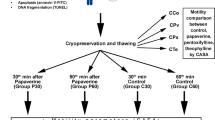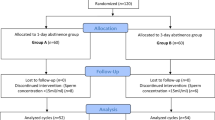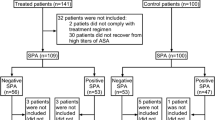Abstract
Objective
Our objective was to study the effect of pentoxifylline (PF) on fertilization rates in couples with previous failure of fertilization and male-factor infertility and to determine the predictive value of conventional semen analysis parameters in selecting the couples who would benefit from the elective use of PF in IVF.
Design
This prospective controlled study was conducted in an assisted conception unit.
Methods
Sixty-nine couples with previous failed IVF cycle, who had a low fertilization rate and/or male-factor infertility, were recruited to the study. Multiple follicular development was induced using the same protocol of human menopausal gonadotropin and gonadotropin releasing hormone analogue in both cycles. The oocytes were inseminated with spermatozoa treated with PF. The fertilization rates in the PF cycle were compared to the reference cycle based on semen analysis parameters and previous fertilization rates.
Results
In couples with male infertility, the fertilization rate improved significantly, from 17 to 50% in PF cycles (P<0.001). A significant improvement in fertilization rate was also demonstrated in couples with previous poor fertilization. <30% (P<0.01). particularly in those with a very low fertilization rate, <20% (P<0.001). Although there was an overall improvement in fertilization rates in couples with male-factor infertility, there was no cutoff value in sperm motility that would make a significant difference in the impact of PF on fertilization rates.
Abstract
Conclusion
Couples with poor fertilization rates in vitro benefit with a significant improvement in fertilization by the elective use of PF. The improvement is most significant in couples with previous complete failure of fertilization and poor fertilization rates, <30%.
Similar content being viewed by others
References
Cohen J, Edwards R, Fehilly C, Fishel S, Hewitt J, Purdy J, Rowland G, Steptoe P, Webster J: In vitro fertilization: A treatment for male factor infertility. Fertil Steril 1985;43:422–432
Madhadevan MM, Trounson AO: The influence of seminal characteristics on the success of human in vitro fertilization. Fertil Steril 1984;42:400–405
Liu DY, Baker HWG: The proportion of human sperm with poor morphology but normal intact acrosomes detected with pisum sativum agglutinin correlates with fertilization in vitro. Fertil Steril 1988;50:288–293
Oehninger S, Acoosta AA, Kruger T, Veeck L, Flood J, Jones HJ: Failure of fertilization in vitro fertilization: The “occult” male factor. J Vitro Fert Embryo Transfer 1988;5:181–187
Avery SM, Elder KT: Routine gamete handling: Semen assessment and preparation.In A Textbook of In Vitro Fertilization and Assisted Reproduction, PR Brinsden, PA Rainsbury (eds). Lancs, UK, Parthenon, 1992, pp 171–185
Van der Ven HH, Hoebbel K, Al-Hasani S, Diedrich K, Krebs D: Fertilization of human oocytes in capillary tubes with very small numbers of spermatozoa. Hum Reprod 1989;4:72–76
Marrs RP, Saito H, Yee B, Sato F, Brown J: Effect of variation of in vitro culture techniques upon oocyte fertilization and embryo development in human in vitro fertilization procedures. Fertil Steril 1984;41:519–523
Quinn P, Kerin JF, Warnes GM: Improved pregnancy rate in human in vitro fertilization with the use of a medium based on the composition of human tubal fluid. Fertil Steril 1985;44:493–498
Khan I, Staessen C, Van den Abbeel E, Camus M, Wisanto A, Smitz J, Devroey P, Van Steirteghem AC: Time of insemination and its effect on in vitro fertilization, cleavage and pregnancy rates in GnRH agonist/HMG-stimulated cycles. Hum Reprod 1989;4:921–926
Ben-Shlomo I, Bider D, Dor J, Levran D, Mashiach S, Ben-Rafael Z: Failure to fertilize in vitro in couples with male factor infertility: What next? Fertil Steril 1992;58:187–189
Hammitt DG, Bedia E, Rogers PR, Syrop CH, Donovan JF, Williamson RA: Comparison of motility stimulants for cyropreserved human semen. Fertil Steril 1989;52:495–502
Mbizvo MT, Johnson RC, Baker GHW: The effect of the motility stimulants caffeine, pentoxifylline, and 2-deoxyadenosine on hyperactivation of cryopreserved human sperm. Fertil Steril 1993;59:1112–1117
Cai X, Marik JJ: Improving penetrating capacity of spermatozoa with poor motility by addition of caffeine at coincubation with zona-free hamster ova. Fertil Steril 1989;51:719–721
Yovich JM, Edirisinghe WR, Cummins JM, Yovich JL: Preliminary results using pentoxifylline in a pronuclear stage tubal transfer (PROST) program for severe male factor infertility. Fertil Steril 1988:50:179–181
Yovich JM, Edirisinghe WR, Cummins JM, Yovich JL: Influence of pentoxifylline in severe male factor infertility. Fertil Steril 1990;53:715–722
Tournaye H, Janssens MT, Camus M, Staessen C, Devroy P, Van Steirteghem A: Pentoxifylline is not useful in enhancing sperm function in cases with previous in vitro fertilization failure. Fertil Steril 1993;59:210–215
World Health Organization: WHO Laboratory Manual for the Examination of Human Semen and Semen Cervical Mucus Interaction, 2nd ed. Cambridge, Press Syndicate of University of Cambridge, 1987
Veeck LL: Morphological estimation of mature oocytes and their preparation for insemination.In In Vitro Fertilization Norfolk, HW Jones, GS Jones, GD Hodgen, Z Rosenwaks (eds). Baltimore, Williams and Wilkins, 1986, pp 81–93
Rizk B, Doyle P, Tan SL, Rainsbury PA, Betts J, Brinsden PR, Edwards RG: Perinatal outcome and congenital malformation in in-vitro fertilization babies from the Bourn Hallam Group. Hum Reprod 1991;6:259–264
Tan SL, Doyle P, Campbell S, Rizk B, Brinsden PR, Edwards RG: Obstetric outcome of in-vitro fertilization pregnancies compared to naturally conceived pregnancy. Am J Obstet Gynecol 1992;167:768–774
Brinsden PR, Rizk B: The obstetric outcome of assisted conception treatment. Assist Reprod Rev 1992;2:116–125
Rizk B, Fountain S, Avery S, Palmer C, Blayney M, Mills C, McNamee M, Brinsden P: Successful use of pentoxifylline in male factor infertility and failure of fertilization: A prospective randomized study (submitted for publication)
Pang SC, Williams DB, Huang T, Wang C: Effects of pentoxifylline on sperm motility and hyperactivated motility in-vitro: A preliminary report. Fertil Steril 1993;59:465–467
Tash JS, Means AR: Cyclic adenosine 3′,5′ monophosphate, calcium and protein phosphorylation in flaggellar motility. Biol Reprod 1983;28:75
Tesarik J, Mendoza C: Sperm treatment with pentoxifylline improves the fertilizing ability as patients with acrosome reaction in sufficiency. Fertil Steril 1993;60:141–148
Yovich JL: Pentoxifylline: Actions and applications in assisted reproduction. Hum Reprod 1993;8:1780–1791
Aitken RJ, Clarkson JS, Hargreave TB, Irvine DS, Wu FCW: Analysis of the relationship between defective sperm function and the generation of reactive oxygen species in cases of oligospermia. J Androl 1991;10:214–220
Gavella M, Lipovac V, Marotti T: Effect of pentoxifylline on superoxide anion production by human sperm. Int J Androl 1991;14:320–327
Lander N, Soloway AH, Minton JP, Rawal BD, Gairola CC: Potential metabolic mutagens of caffeine and various methylaxanthines. J Pharmacol Sci 1988;32:213–218
Spindle A, Wu K: Developmental and cytogenic effects of caffeine on mouse blastocysts, alone, or in combination with benzo(a)pyrene. Teratology 1985;32:213–218
Tasdemir M, Tasemir I, Kodama H, Tanaka T: Pentoxifylline-enhanced acrosome reaction correlates with fertilization in vitro. Hum Reprod 1993;8:210–217
Author information
Authors and Affiliations
Rights and permissions
About this article
Cite this article
Fountain, S., Rizk, B., Avery, S. et al. An evaluation of the effect of pentoxifylline on sperm function and treatment outcome of male-factor infertility: A preliminary study. J Assist Reprod Genet 12, 704–709 (1995). https://doi.org/10.1007/BF02212897
Received:
Accepted:
Issue Date:
DOI: https://doi.org/10.1007/BF02212897




